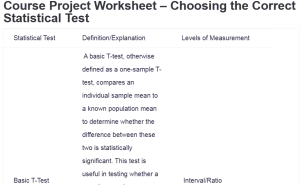Course Project Worksheet – Choosing the Correct Statistical Test
| Statistical Test | Definition/Explanation | Levels of Measurement |
| Basic T-Test | A basic T-test, otherwise defined as a one-sample T-test, compares an individual sample mean to a known population mean to determine whether the difference between these two is statistically significant. This test is useful in testing whether a sample mean is significantly different from a hypothesized population mean (Pyrczak & Oh, 2018). In general, it works for normally distributed continuous data and informs about the testing of hypotheses concerning one group. | Interval/Ratio |
| Independent Sample T-Test | The t-test for independent samples is also known as a two-sample t-test and is a method used to determine the significance of differences between two independent means (Ross & Willson, 2017). This test is particularly useful in comparing two different groups across unmatched data samples. In the process, it assumes that the distribution of data from each group is normal. This test is applicable to compare the means of two unrelated groups, for instance, a treatment versus a control group. | Interval/Ratio |
| Paired T-Test | The paired T-test, sometimes called the dependent sample T-test, compares means across two related groups; for instance, pretest and post-test scores for the same subjects (Tabachnick & Fidell, 2019). It tests differences in means of a single sample over two conditions. It assumes data are normally distributed and is thus useful in repeated measures or matched pairs for all before-and-after studies. | Interval/Ratio |
| Analysis of Variance (ANOVA) Test | The ANOVA, or the Analysis of Variance tests the difference in means across three or more groups to optionally determine whether at least one group’s mean differs significantly from others. This analysis assumes normality and homogeneity of variances across groups, and it works effectively when comparing multiple groups or treatments together. One of the major advantages of ANOVA is that it prevents inflating the error rates that would have been experienced if multiple T-tests had been conducted. | Interval/Ratio |
| Chi-Square Test | The Chi-Square test evaluates the relationships of categorical variables by comparing the observed frequencies against the expected frequencies. The Chi-Square test is very helpful with nominal data to establish if there is any association or independence between categories, such as gender versus preference. This test does not assume the normality of distribution; hence, it is appropriate for data that is either nominal or ordinal. | Nominal |
| Regression Test | A regression test is carried out between a dependent variable and one or more independent variables to predict the value that the dependent variable will take once the values of the independent variables are forecast. Simple linear regression has one predictor variable, while multiple regression involves several predictors. Regression is perfect in instances where there is continuous data on the dependent variable and it provides information about strength and direction in relationships. | Interval/Ratio for dependent variable; independent can be nominal, ordinal, or interval |
References
Pyrczak, F., & Oh, D. M. (2018). Making Sense of Statistics. Routledge. https://doi.org/10.4324/9781315179803
Ross, A., & Willson, V. L. (2017). Independent samples t-test. Basic and Advanced Statistical Tests, 13–16. https://doi.org/10.1007/978-94-6351-086-8_3
Tabachnick, B. G., & Fidell, L. S. (2019). Using multivariate statistics (7th ed.). Boston Pearson.
ORDER A PLAGIARISM-FREE PAPER HERE
We’ll write everything from scratch
Question 
An important component to hypothesis testing is choosing the appropriate test to compute the test statistic. In the second column, define and explain statistical test listed in the first column. Be sure tonote when each test is used, why you would choose this test, and what the output tells us. Be sure to
provide a rationale for each test choice, including variable types. Then in the third column, specify what level(s) of measurement each test is used with.
| Statistical Test | Definition/Explanation | Levels of Measurement |
| Basic T-Test | ||
| Independent Sample T-Test | ||
| Paired T-Test | ||
| Analysis of Variance (ANOVA) Test | ||
| Chi-Square Test | ||
| Regression Test |
References
[List references according to APA guidelines.]

Course Project Worksheet – Choosing the Correct Statistical Test